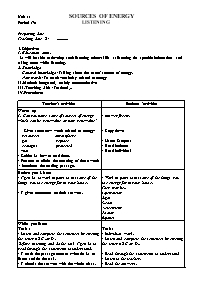Bài soạn môn học Tiếng Anh 11 - Unit 11: Sources of energy - Period 70: Listening

I. Objectives
1. Education aims:
Ls will be able to develop such listening micro-skills as listening for specific information and taking notes while listening.
2. Knowledge
General knowledge: Talking about the use of sources of energy.
New words: To teach vocabulay related to energy
II. Method:Integrated, mainly communicative
III. Teaching Aids: Textbook,.
IV.Procedure:
Bạn đang xem tài liệu "Bài soạn môn học Tiếng Anh 11 - Unit 11: Sources of energy - Period 70: Listening", để tải tài liệu gốc về máy bạn click vào nút DOWNLOAD ở trên
Unit 11 SOURCES OF ENERGY Period :70 LISTENING Preparing date: Teaching date :B4........... I. Objectives 1. Education aims: Ls will be able to develop such listening micro-skills as listening for specific information and taking notes while listening. 2. Knowledge General knowledge: Talking about the use of sources of energy. New words: To teach vocabulay related to energy II. Method:Integrated, mainly communicative III. Teaching Aids: Textbook,.. IV.Procedure: Teacher’s activities Students’activities Warm up 1. Can you name some of sources of energy which can be renewable or non- renewable? Gives some new words related to energy: + resources +atmostphere + gas + replace + ecologist + protected +vital - Guides Ls how to read them. - Presents or elicits the meaning of these words - Introduce the reading passage. - Answer freely. - Copy down - Listen & repeat - Read inchrous - Read individual Before you Listen - T gets Ls to work in pairs to list some of the things you use energy for in your house. - T gives comments on their answers. - Work in pairs to list some of the things you use energy for in your house. They may be.. 1.petroleum 2.gas 3.coal 4.electricity 5.solar 6.panel While you listen Task 1 - Listen and complete the sentences by circling the letter A,B,C,or D. Before listening and do the task, T gets Ls to read through the statements to understand. - T reads the passage once or twice for Ls to listen and do the task. - T checks the answers with the whole class. - Feedback and give correct answers. Answers; 1.D 2.C 3.D 4.A 5.C Task 1 - Individual work. - Listen and complete the sentences by circling the letter A,B,C,or D.. - Read through the statements to understand - Listen to the teacher. - Read the answers. -Check again Task 2 - Guides: - Asks Ls to listen again to the last part of the talk and write in the missing words. T checks if Ls can do the task without listening one more time. If they cannot, T reads the passage again.But before doing it, T asks Ls to study the text carefully for the missing words they need to fill in and guess the the answers.T might aslo want to remind Ls that while listening they need to focus on these words and write the answers down in the blanks. - Asks Ls to work in individual. - Let Ls listen one more time. - Call some Ls to explain their answers - Give correct answers. Ans: 1.unlimited 2.atmostphere 3.may 4.gases 5.amount. Task 2 Whole class - Read through the statements to understand - Ls to study the passage carefully for the missing words they need to fill in and guess the answers. - Listen again to the last part of the talk and write in the missing words. - Work in individual. - Report your results in front of the class. - Correct again. After you listen - Asks Ls to work in group and answer question. Which group do these sources of energy belong to ? Put a tick in the right column - Go around the class and offer help if necessary. - Call some groups to read their answers in front of the class. - Feedback and give suggested answers. - Comment and make necessary corrections - Work in group Discuss the Qs in the book Which group do these sources of energy belong to ? Put a tick in the right column -Suggested answers. Sources of energy Non-renewable Renewable Coal x Geothemal heat x Petroleum x Solar energy x Oil x Wind energy x Gas x * Homework: - Summarise the main points - Work at home
Tài liệu đính kèm:
 UNIT 11LISTENIG (3).doc
UNIT 11LISTENIG (3).doc





